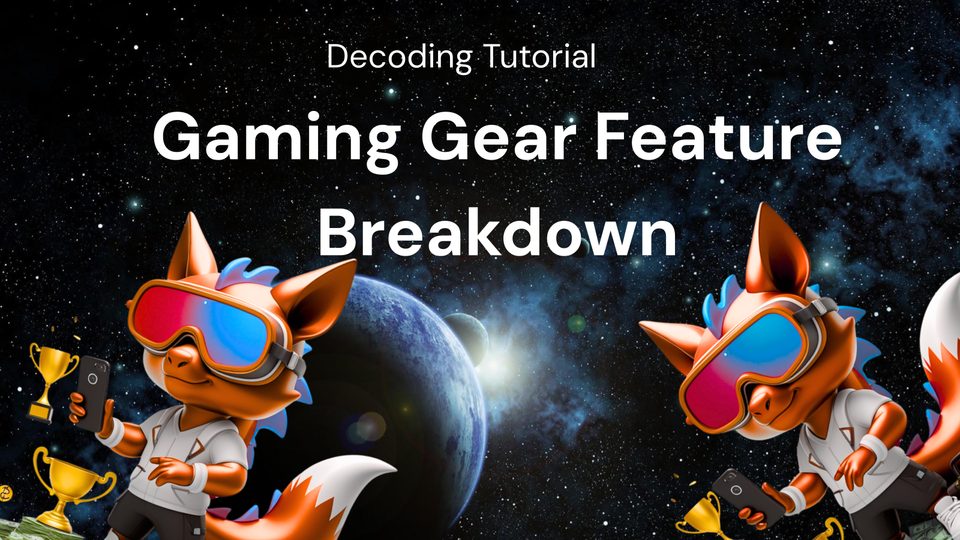Decoding Gaming Gear: A Feature Breakdown Tutorial

Decoding Gaming Gear: A Feature Breakdown Tutorial
The world of gaming gear can feel like navigating a minefield of jargon and technical specifications. From refresh rates to actuation points, DPI to polling rates, understanding what these features actually mean and how they impact your gameplay is crucial to making informed purchasing decisions and unlocking your full potential. This comprehensive guide aims to demystify the most important aspects of gaming peripherals, providing you with the knowledge to choose the right gear for your specific needs and preferences.
I. Gaming Mice: Precision and Performance in Your Palm
A gaming mouse is your direct connection to the virtual world, demanding precision, responsiveness, and comfort. Here's a breakdown of the key features:
A. Sensor Technology: The Heart of Accuracy
- Optical vs. Laser Sensors: The primary difference lies in how the sensor tracks movement.
- Optical Sensors: Employ an LED light source to illuminate the surface and a camera to capture images. These images are then processed to determine movement. Typically, optical sensors offer superior tracking accuracy on a wider range of surfaces and are less prone to acceleration issues.
- Laser Sensors: Use a laser beam to illuminate the surface. Laser sensors can function on almost any surface, including glass, but often introduce acceleration issues. They are generally more susceptible to dust and imperfections, leading to inconsistencies in tracking.
- DPI (Dots Per Inch): DPI refers to the sensitivity of the mouse. A higher DPI means the cursor moves further on screen with the same physical movement of the mouse. While higher DPI might sound better, it's not always the case. Most gamers find a DPI range between 400-1600 DPI to be optimal for accuracy and control. Experiment to find what feels most comfortable and precise for your playstyle.
- IPS (Inches Per Second): IPS represents the maximum speed at which the mouse can be moved while still accurately tracking movement. A higher IPS rating indicates that the mouse can handle faster movements without losing accuracy. For most gamers, an IPS rating of 250 or higher is sufficient.
- Acceleration: Ideally, your mouse should have zero acceleration. Acceleration means that the cursor movement is not directly proportional to the physical movement of the mouse. For example, moving the mouse a short distance quickly might result in a larger cursor movement than moving it the same distance slowly. This can lead to inconsistent aiming and reduced accuracy. Look for mice specifically marketed as having "zero acceleration."
- Polling Rate: Measured in Hz (Hertz), polling rate refers to how often the mouse reports its position to the computer. A polling rate of 1000Hz means the mouse reports its position 1000 times per second, resulting in a faster and more responsive feel. While higher polling rates are generally better, the difference between 500Hz and 1000Hz may be imperceptible to some users.
B. Ergonomics and Grip Style: Comfort is Key
- Palm Grip: The entire palm rests on the mouse. This grip style is best suited for larger mice with a higher profile.
- Claw Grip: Only the palm's rear rests on the mouse, with fingers arched for precise clicking. This grip style works well with smaller mice with a flatter profile.
- Fingertip Grip: Only the fingertips make contact with the mouse. This grip style allows for maximum maneuverability and is ideal for fast-paced games. Requires a smaller, lighter mouse.
- Mouse Weight: A lighter mouse allows for faster movements and less fatigue, while a heavier mouse provides more stability and control. The ideal weight is subjective and depends on your personal preference and grip style.
- Button Placement and Programmability: Consider the number of buttons and their placement. Programmable buttons can be invaluable for assigning macros and custom actions, allowing for quick access to in-game commands.
C. Wired vs. Wireless: Latency and Convenience
- Wired Mice: Offer the lowest latency and a consistent connection, making them ideal for competitive gaming. They are also generally more affordable.
- Wireless Mice: Provide freedom of movement and a cleaner setup, but traditionally suffered from higher latency. Modern wireless technology has significantly reduced latency, making some wireless mice virtually indistinguishable from their wired counterparts. Consider battery life and charging requirements when choosing a wireless mouse.
II. Gaming Keyboards: Responsiveness and Customization
A gaming keyboard is more than just a typing tool; it's a command center for your digital battles.
A. Switch Types: The Feel of Victory
- Mechanical Switches: Offer distinct tactile feedback and audible clicks, providing a more responsive and satisfying typing experience.
- Cherry MX Switches: The gold standard for mechanical switches, available in various types with different characteristics.
- Red: Linear switch with no tactile bump or audible click. Requires minimal force for actuation, making them ideal for fast-paced games.
- Brown: Tactile switch with a noticeable bump that provides feedback when the key is actuated, but without a loud click. A good all-around option for gaming and typing.
- Blue: Tactile switch with both a noticeable bump and an audible click. Offers strong feedback but can be noisy.
- Speed Silver: A lighter and faster version of the Red switch, requiring even less force for actuation.
- Black: A stiffer version of the Red switch, requiring more force to actuate, preventing accidental key presses.
- Other Switch Manufacturers: Kailh, Gateron, and Razer are popular alternatives that offer a wide variety of switch types with different characteristics and price points.
- Cherry MX Switches: The gold standard for mechanical switches, available in various types with different characteristics.
- Membrane Keyboards: Use a rubber dome under each key, providing a softer and quieter typing experience. Typically less expensive than mechanical keyboards but offer less tactile feedback and responsiveness.
- Actuation Point: The distance a key needs to be pressed before it registers. A shorter actuation point allows for faster key presses and quicker response times.
- Actuation Force: The amount of force required to press a key. Lighter switches require less force, allowing for faster and less fatiguing typing.
B. Layout and Size: Finding the Right Fit
- Full-Size Keyboards: Include all 104 keys, including a numpad.
- Tenkeyless (TKL) Keyboards: Omit the numpad, making them more compact and ergonomic.
- 60% Keyboards: Remove the function row, arrow keys, and other less frequently used keys, resulting in a highly compact design. Requires learning function layer commands.
- Ergonomic Keyboards: Designed to promote a more natural typing posture, reducing strain on the wrists and hands. Often feature split layouts or angled key arrangements.
C. Keycaps and Materials: Aesthetics and Durability
- ABS (Acrylonitrile Butadiene Styrene) Keycaps: The most common type of keycap, typically less expensive but can become shiny and wear down over time.
- PBT (Polybutylene Terephthalate) Keycaps: More durable and resistant to shine than ABS keycaps. Offer a more textured feel and hold their color better over time.
- Double-Shot Keycaps: Two pieces of plastic are molded together, creating legends that won't fade or wear off.
- Laser-Etched Keycaps: Legends are burned into the keycap using a laser. Can wear down over time.
- Printed Keycaps: Legends are printed onto the keycap. The least durable option.
D. Features and Customization: Enhancing the Experience
- RGB Lighting: Allows for customization of the keyboard's backlighting with a wide range of colors and effects.
- Macro Keys: Programmable keys that can be assigned to execute complex sequences of commands.
- Anti-Ghosting and N-Key Rollover: Anti-ghosting prevents key presses from being missed when multiple keys are pressed simultaneously. N-Key Rollover allows for an unlimited number of simultaneous key presses to be registered.
- Detachable Cable: Allows for easy storage and replacement of the cable.
III. Gaming Headsets: Immersive Audio and Clear Communication
A gaming headset provides immersive audio and clear communication, enhancing your gaming experience and providing a competitive edge.
A. Sound Quality: Hear Every Detail
- Driver Size: Larger drivers typically produce a wider frequency response and deeper bass.
- Frequency Response: The range of frequencies the headset can reproduce. A wider frequency response allows you to hear more details in the audio.
- Impedance: The resistance of the headphones to the electrical signal. Lower impedance headphones are easier to drive and can be used with a wider range of devices. Higher impedance headphones typically require an amplifier to deliver their full potential.
- Surround Sound: Simulates a multi-channel audio experience, allowing you to hear sounds from different directions.
- Virtual Surround Sound: Uses software to simulate surround sound through two headphones.
- True Surround Sound: Uses multiple drivers in each earcup to create a more realistic surround sound experience.
B. Microphone Quality: Communicate Clearly
- Microphone Type:
- Omnidirectional: Picks up sound from all directions.
- Unidirectional: Picks up sound primarily from one direction, reducing background noise.
- Bidirectional: Picks up sound from two directions, typically used for recording conversations.
- Noise Cancellation: Reduces background noise, ensuring clear communication.
- Microphone Sensitivity: Determines how well the microphone picks up sound.
C. Comfort and Design: Hours of Enjoyment
- Earcup Type:
- Over-Ear (Circumaural): Encapsulates the entire ear, providing better sound isolation and comfort.
- On-Ear (Supra-Aural): Rests on the ear, providing less sound isolation but can be more comfortable for some users.
- Headband Material: Padding and adjustability are crucial for comfort during long gaming sessions.
- Weight: A lighter headset will be more comfortable to wear for extended periods.
D. Wired vs. Wireless: Freedom vs. Reliability
- Wired Headsets: Offer the lowest latency and a consistent connection.
- Wireless Headsets: Provide freedom of movement but may have higher latency and require charging.
IV. Monitors: Visual Fidelity and Responsiveness
Your monitor is the window to your virtual world, influencing visual clarity, responsiveness, and immersion.
A. Panel Technology: Colors and Viewing Angles
- TN (Twisted Nematic) Panels: Offer the fastest response times and refresh rates, making them ideal for competitive gaming. However, they typically have narrower viewing angles and less accurate colors than other panel types.
- IPS (In-Plane Switching) Panels: Provide excellent color accuracy and wide viewing angles, making them suitable for immersive gaming experiences and content creation. Typically have slower response times than TN panels.
- VA (Vertical Alignment) Panels: Offer a good balance between color accuracy, viewing angles, and response times. They also have high contrast ratios, providing deep blacks and vibrant colors.
B. Resolution and Refresh Rate: Clarity and Smoothness
- Resolution: The number of pixels on the screen. Higher resolutions provide sharper and more detailed images.
- 1080p (1920x1080): A common resolution for gaming, offering a good balance between performance and visual quality.
- 1440p (2560x1440): Provides a sharper image than 1080p and is becoming increasingly popular among gamers.
- 4K (3840x2160): Offers the highest level of detail and visual clarity, but requires a powerful graphics card to run games at high frame rates.
- Refresh Rate: The number of times the monitor refreshes the image per second, measured in Hz. A higher refresh rate results in smoother and more responsive gameplay.
- 60Hz: The standard refresh rate for most monitors.
- 144Hz: A popular refresh rate for gaming, providing a significant improvement in smoothness and responsiveness.
- 240Hz: Offers the highest level of smoothness and responsiveness, but requires a powerful graphics card to maintain high frame rates.
C. Response Time: Minimizing Motion Blur
- Response Time: The time it takes for a pixel to change from one color to another, measured in milliseconds (ms). A lower response time reduces motion blur and ghosting, resulting in a clearer and more responsive image. Look for monitors with a response time of 5ms or lower for gaming.
D. Adaptive Sync Technology: Eliminating Screen Tearing
- G-Sync (NVIDIA): Synchronizes the monitor's refresh rate with the graphics card's frame rate, eliminating screen tearing and reducing stuttering. Requires an NVIDIA graphics card.
- FreeSync (AMD): Similar to G-Sync but is compatible with AMD graphics cards and is typically more affordable.
E. Other Considerations:
- Panel Size: Choose a size that is appropriate for your viewing distance and desk space.
- Curvature: Curved monitors can provide a more immersive gaming experience.
- HDR (High Dynamic Range): Provides a wider range of colors and contrast, resulting in a more vibrant and realistic image.
V. Conclusion: The Right Gear for the Right Game
Choosing the right gaming gear is a personal decision based on your individual preferences, playstyle, and budget. By understanding the features and specifications discussed in this guide, you can make informed purchasing decisions and equip yourself with the tools you need to elevate your gaming experience to the next level. Remember to prioritize factors like comfort, ergonomics, and responsiveness, and don't be afraid to experiment with different gear until you find what works best for you. Happy gaming!




Comments ()